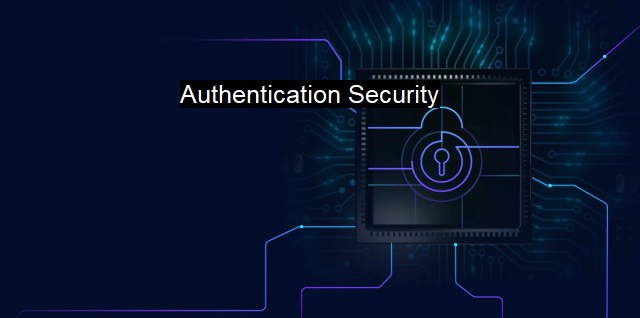What is Authentication Security?
Ensuring Robust Authentication Security for Cybersecurity: Protecting Sensitive Data and Vulnerable Assets from Cyberattacks
Authentication security, with refers to the series of measures and tactics put into place to validate the identities of devices, users, and systems. These measures confirm that those attempting to gain access to specific resources are indeed authorized and not perpetrators trying to breach the system, steal data, launch attacks, or manipulate information. It is an essential deterrent tool in the far-reaching armory of cybersecurity mechanisms targeted at protecting corporate IT assets and individual resources.At its core, authentication security works by confirming that users are who they claim, establishing confidence between digital enterprises and their users. Access is granted based on the credentials users provide, which the system confirms. These criteria could be something they know, like a password, something they have, like a hardware token, or something they are, such as a biometric marker like a fingerprint.
The place of authentication security in cybersecurity cannot be overemphasized. Its function transcends the mere act of barring unauthorized access to systems and data. It serves as a proactive shield, designed to detect unusual events, trace the histories of users, and arguably prevent several malicious engagements before they even unfold. Some common authentication methods include token-based, biometrics, multi-factor, mobile device, security questions, certificate-based (SSL/TLS), and decentralized (blockchain).
As important as authentication security is, there remain concerns and threats to its efficiency. There exists the possibility of compromise or bypass, particularly with single-factor (typically password-based) methods. Cybercriminals can manipulate weak, common, or stolen passwords using techniques like Bruteforce attacks, keylogging, or phishing. The perils of dictionary and social engineering attacks have also highlighted the need for more robust mantras against pervasive threats.
This has led to the rise in multi-factor authentication security (MFA), where two or more unconnected validation factors are necessitated, thereby compounding the intricacy, and minimizing a potential breach via a single point. a system might require not only a password, but also a dynamic one-time code sent to the user's verified mobile device.
Antivirus software, a critical counterpart in the overall cybersecurity sphere, provides another layer of authentication security. These programs are designed to detect, prevent, and remove viruses and malware, safeguarding individuals and enterprises against potential breaches that could bypass authentication. Much like virus detection in human healthcare, antivirus software constantly monitors for known threats and suspicious behavior, validating the authenticity of system activities.
Authentication security metalayers are often complemented with the establishment of firewalls for network security or endpoint security measures; they are devised to ascertain system, device, and user identities making alterations to specific resources.
It is safe to say that authentication security is more than a mere access barrier. It is the bedrock giving all users the confidence that their data and activities are secure. Should the authentication process fail, consequences could range from unauthorized access through reputation damage to legal, compliance, and financial impacts.
Emerging advancements like artificial intelligence, machine learning, and blockchain technology for Authentication security systems promise added layers of robustness and flexibility. These burgeoning technologies will contribute significantly towards not just the error-free identification of authorized users, but also towards a more granular observation and prediction of end-user behavior, spotting abnormalities, monitoring risks, and enhancing the overall dynamism in the cybersecurity environment.
Authentication security remains the backbone of robust cybersecurity measures, striving to create a seamless, safe internet for all users. A common slogan in the cybersecurity ecosystem reads "trust, but verify." This underscores the essence of authentication security, continuous verification, and re-verification of system's elements, fostering confidence in the system and guaranteeing a heightened level of cybersecurity to keep users and systems safe.

Authentication Security FAQs
What is authentication security in cybersecurity?
Authentication security in cybersecurity refers to a set of measures that are put in place to verify the identity of users who access systems or data. This is done to prevent unauthorized access, data breaches, and other cyber threats.Why is authentication security important for antivirus software?
Authentication security is important for antivirus software because it enables the software to verify the identity of users and ensure that they are authorized to access the software. This helps to prevent unauthorized access and protect the software from attacks.What are some common authentication security measures used in cybersecurity?
Some common authentication security measures used in cybersecurity include passwords, biometrics, two-factor authentication, multi-factor authentication, and security tokens. These measures help to confirm the identity of users and protect against unauthorized access.What are some best practices for improving authentication security in cybersecurity?
Some best practices for improving authentication security in cybersecurity include using strong and unique passwords, implementing two-factor or multi-factor authentication, regularly updating and patching software, and training employees on how to identify and avoid phishing attacks.| | A | | | B | | | C | | | D | | | E | | | F | | | G | | | H | | | I | | | J | | | K | | | L | | | M | |
| | N | | | O | | | P | | | Q | | | R | | | S | | | T | | | U | | | V | | | W | | | X | | | Y | | | Z | |
| | 1 | | | 2 | | | 3 | | | 4 | | | 7 | | | 8 | | |||||||